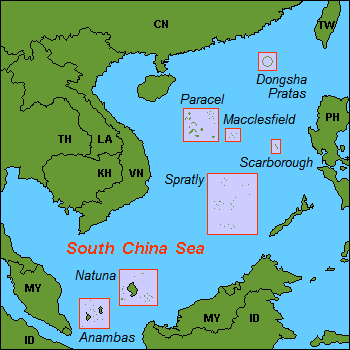Indonesia had another high-seas encounter with China—but this time it brought a bigger boat


In March, an Indonesian patrol boat captured a Chinese fishing trawler illegally operating within Indonesia’s territorial waters. Before it could impound the offending vessel, however, two Chinese coast guard vessels appeared, stole back the trawler, and towed it back to international waters, leaving the Indonesians with only the Chinese crew to show for their efforts.
Last week there was a another, similar encounter, but with different outcome. This time around, the Indonesians brought a bigger boat: a Navy destroyer.
Both of the incidents took place around Indonesia’s remote Natuna islands, northwest of Borneo in the South China Sea. Beijing acknowledged last November that the islands belong to Indonesia.

China claims almost the entire South China Sea as its own, based partly on a nine-dash line drawn on a map shortly after World War 2. It’s been aggressively bolstering that claim with island-building, militarization, and diplomatic maneuverings.
The exclusive economic zone of the Natunas intersects with China’s nine-dash line. That zone, prescribed by the United Nations Convention on the Law of the Sea, extends 200 nautical miles from the coast, and within it a nation has the rights to marine, energy, and other resources.
But while China conceded the Natunas to Indonesia, it didn’t mention anything (paywall) about the exclusive economic zone, which it doesn’t seem to have much respect for judging by the intrusions of its well-backed “fishing militia.” In March China’s foreign ministry called the area where the episode took place “traditional Chinese fishing grounds.” And China’s fishing fleet ignores the exclusive economic zones of many nations—even distant Argentina’s.
That’s a big reason why Indonesia has since last year been beefing up its military presence in the Natunas, sending soldiers, fighter jets, and warships to the islands, and upgrading a small military base. Last month it even added networked nano-satellites orbiting the planet to its arsenal, so it can more easily decide where to send patrol ships. “We aspire to turn Natuna Air Force base into an integrated military base—the Pearl Harbor of Indonesia,” Indonesian air force commander Agus Supriatna told Antara last November.
In the incident last week, the Chinese fishing trawler, called the Gui Bei Yu 27088, was intercepted by the Indonesian destroyer Oswald Siahaan-354, which blocked a rescue attempt by a Chinese coast guard vessel. The Indonesian Navy said it fired shots at the trawler when it refused to stop fishing, then seized it.
The Chinese crew is now in Indonesian custody awaiting prosecution under Indonesia’s fisheries laws—and this time, so is their trawler.

Sign up for the Quartz Daily Brief, our free daily newsletter with the world’s most important and interesting news.
More stories from Quartz:

 Yahoo Finance
Yahoo Finance 